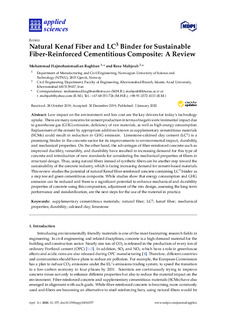| dc.contributor.author | Hajmohammadian Baghban, Mohammad | |
| dc.contributor.author | Mahjoub, Reza | |
| dc.date.accessioned | 2020-01-30T12:28:49Z | |
| dc.date.available | 2020-01-30T12:28:49Z | |
| dc.date.created | 2020-01-15T21:32:12Z | |
| dc.date.issued | 2020 | |
| dc.identifier.issn | 2076-3417 | |
| dc.identifier.uri | http://hdl.handle.net/11250/2638874 | |
| dc.description.abstract | Low impact on the environment and low cost are the key drivers for today’s technology uptake. There are many concerns for cement production in terms of negative environmental impact due to greenhouse gas (GHG) emission, deficiency of raw materials, as well as high energy consumption. Replacement of the cement by appropriate additives known as supplementary cementitious materials (SCMs) could result in reduction in GHG emission. Limestone-calcined clay cement (LC3) is a promising binder in the concrete sector for its improvements to environmental impact, durability, and mechanical properties. On the other hand, the advantages of fiber-reinforced concrete such as improved ductility, versatility, and durability have resulted in increasing demand for this type of concrete and introduction of new standards for considering the mechanical properties of fibers in structural design. Thus, using natural fibers instead of synthetic fibers can be another step toward the sustainability of the concrete industry, which is facing increasing demand for cement-based materials. This review studies the potential of natural Kenaf fiber-reinforced concrete containing LC3 binder as a step toward green cementitious composite. While studies show that energy consumption and GHG emission can be reduced and there is a significant potential to enhance mechanical and durability properties of concrete using this composition, adjustment of the mix design, assessing the long-term performance and standardization, are the next steps for the use of the material in practice. | nb_NO |
| dc.language.iso | eng | nb_NO |
| dc.publisher | MDPI | nb_NO |
| dc.rights | Navngivelse 4.0 Internasjonal | * |
| dc.rights.uri | http://creativecommons.org/licenses/by/4.0/deed.no | * |
| dc.title | Natural Kenaf Fiber and LC3 Binder for Sustainable Fiber-Reinforced Cementitious Composite: A Review | nb_NO |
| dc.type | Journal article | nb_NO |
| dc.type | Peer reviewed | nb_NO |
| dc.description.version | publishedVersion | nb_NO |
| dc.source.journal | Applied Sciences | nb_NO |
| dc.identifier.doi | https://doi.org/10.3390/app10010357 | |
| dc.identifier.cristin | 1774271 | |
| dc.description.localcode | © 2020 by the authors. Licensee MDPI, Basel, Switzerland. This article is an open access article distributed under the terms and conditions of the Creative Commons Attribution (CC BY) license (http://creativecommons.org/licenses/by/4.0/). | nb_NO |
| cristin.unitcode | 194,64,94,0 | |
| cristin.unitname | Institutt for vareproduksjon og byggteknikk | |
| cristin.ispublished | true | |
| cristin.fulltext | original | |
| cristin.qualitycode | 1 | |

